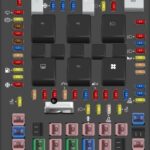Navigating the world of automotive diagnostics can be confusing, especially when it comes to understanding which diagnostic system your vehicle uses. For owners of the robust and reliable 1995 Ford F150, a common question arises: Is it equipped with OBD1 or the more modern OBD2 system? The answer is that the 1995 Ford F150 is indeed an OBD1 vehicle. This means that accessing diagnostic trouble codes isn’t as straightforward as plugging in a standard OBD2 scanner, but it’s still entirely achievable, often without any special tools beyond a simple piece of wire.
Understanding and reading these codes is the first step in diagnosing engine issues and keeping your classic F150 running smoothly. This guide will walk you through the process of retrieving these codes yourself using the Check Engine Light (CEL) on your dashboard.
Understanding OBD1 in Your 1995 F150
Before we jump into reading codes, it’s helpful to understand why your 1995 F150 uses OBD1. On-Board Diagnostics (OBD) systems were introduced to monitor vehicle emissions and engine performance. OBD1 was the first generation of these systems, and while not as standardized or comprehensive as OBD2, it still provides valuable diagnostic information. OBD2 became mandated in the USA for all cars manufactured from 1996 onwards, which is why your 1995 model year F150 falls under the OBD1 category.
Step-by-Step Guide to Reading OBD1 Codes on a 1995 Ford F150
Reading OBD1 codes on your 1995 F150 involves performing a Key On Engine Off (KOEO) test. This method utilizes the flashing patterns of your Check Engine Light to communicate the stored trouble codes. Here’s how to do it:
-
Locate the EEC Test Connector: Open your hood and find the EEC (Engine Control Computer) test connector. It’s typically located on the driver’s side fender well, near the firewall. You’re looking for a black, plastic connector, often clipped into a protective plastic housing and not connected to anything else.
-
Identify the Diagnostic Connectors: Within this protective housing, you should find two connectors:
- A larger connector, usually black, with six terminals.
- A smaller, single gray connector.
-
Prepare Your Jumper Wire: You’ll need a short piece of wire – a paper clip straightened out also works perfectly. This will act as your jumper to initiate the diagnostic test.
-
Connect the Jumper Wire:
- Orient the larger 6-terminal connector so that the row of four terminals is at the bottom and the row of two terminals is at the top.
- Insert one end of your jumper wire into the top right terminal of the larger connector (the rightmost terminal of the 2-terminal row).
- Connect the other end of your jumper wire to the single gray connector.
-
Turn the Key to the “Run” Position: Turn your ignition key to the “Run” position. Do not start the engine.
-
Observe the Check Engine Light Flashes: Now, watch your Check Engine Light closely. It will begin to flash a series of codes. These flashes are how the OBD1 system communicates trouble codes.
-
Reading the Codes: The codes are communicated in a two-digit format. Let’s take the example of code “212”:
- The CEL will flash twice, then pause briefly. This indicates the first digit “2”.
- After a slightly longer pause, the CEL will flash once. This indicates the digit “1”.
- Then, after another brief pause, the CEL will flash twice again, indicating the final digit “2”.
- There will be a longer, 4-second pause between each complete two-digit code.
Write down each code as it is flashed. The codes will be displayed in numerical order.
-
KOEO and Continuous Codes:
- First, you will see the KOEO (Key On Engine Off) codes.
- After the KOEO codes are finished, there will be a 6-second pause, followed by a single flash, and another 6-second pause. This sequence signals the end of the KOEO codes and the beginning of Continuous Codes (also known as CM codes or memory codes).
- The Continuous Codes will then be displayed in the same flashing pattern as the KOEO codes. These codes represent issues that may be intermittent or stored in the computer’s memory from previous driving cycles.
-
Clearing Codes (Optional): If you wish to clear the stored codes after diagnosing and fixing the issue, you can simply unplug the jumper wire while the test is running. However, it’s generally recommended to address the underlying problem before clearing codes.
Interpreting Your OBD1 Codes
Once you have retrieved the codes, the next crucial step is to interpret them. OBD1 codes for Ford vehicles are typically two-digit codes. You will need a Ford OBD1 code list to understand what each code signifies. These lists are readily available online with a quick search for “1995 Ford OBD1 codes” or “Ford EEC-IV codes”.
For example, code 212 on a Ford OBD1 system often relates to “Ignition Coil Primary Circuit Failure” or “Loss of IDM input to EEC.” However, code definitions can sometimes vary slightly depending on the specific engine and year, so always refer to a reliable code chart specific to your 1995 Ford F150.
Beyond Reading Codes: Further Diagnosis
Reading OBD1 codes on your 1995 F150 is a valuable DIY diagnostic step. It can point you in the right direction for troubleshooting engine problems. However, keep in mind that the codes provide a starting point. Further investigation and testing are often needed to pinpoint the exact cause of the issue. This might involve:
- Consulting a repair manual specific to your 1995 Ford F150.
- Using a multimeter to test electrical components.
- Visually inspecting sensors, wiring, and vacuum lines.
While OBD1 systems are less sophisticated than OBD2, they are still effective in helping diagnose issues on older vehicles like the 1995 Ford F150. By following these steps, you can access valuable diagnostic information and take a proactive approach to maintaining your truck. Remember to always consult repair manuals and seek professional help when needed to ensure accurate diagnosis and repair.
